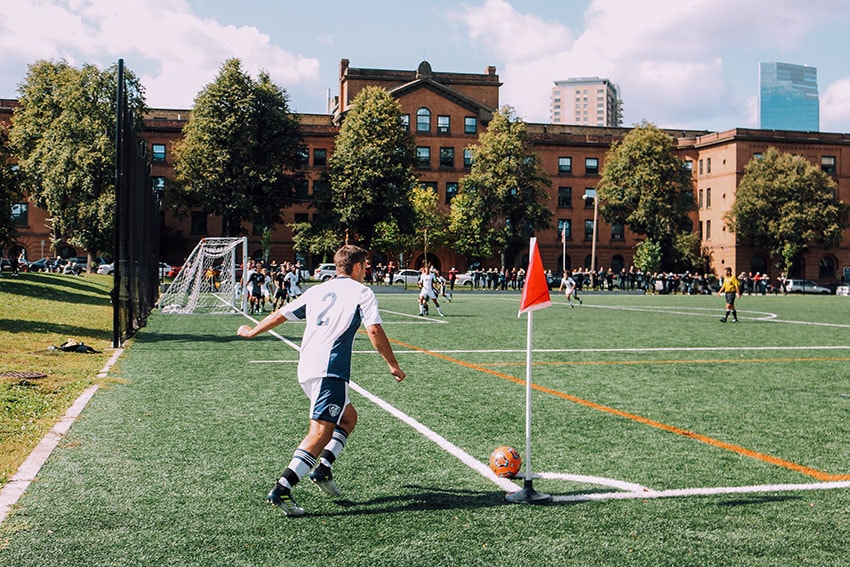Athletes often use a technique called “visualization” to improve their chances of success. For example, the athlete imagines an act such as hitting a baseball or envisions reacting during a competitive situation. It is believed that if the athlete sees herself performing a particular skill, it will improve her chances of actually performing that skill successfully. In other words, to achieve success, one must be able to visualize what success will look like.
The purpose of this essay is to encourage the reader to envision success of another sort: the successful transformation of the role that athletics plays in our high schools, and as a result, in our society. I am not talking about change around the fringes, but a progressive vision of systemic change. A vision of change from the current “elite” model of sports in America, where the vast majority of resources are heaped upon the few who show extraordinary potential, to one that would have as its fundamental purposes, to use athletics as a tool to supplement the educational development of participants, to support the missions of our educational institutions, and to promote broad based participation in activities that can be practiced for a lifetime for purposes of public health.
This is not about the intrinsic value of athletics, but whether the current system is best suited for making the most of athletics’ potential to meet our nation’s education and public health needs. There is a place for elite athletics in our culture. The question is simply whether that place should be in our schools.
Elite sport is an important American cultural institution. As such, we as individuals and, collectively, as a society, must critically assess its impact on our schools, communities and culture. This is no different than other American institutions. From our health care system to our welfare system, old ideas, programs, institutions, and philosophies must continually be examined, refined and, if appropriate, restructured. And the fundamental standard of evaluation is utility. Do these institutions continue to serve the public in relevant and timely ways? If it is determined, through honest debate and data based research, that elite athletics have a positive impact on educational institutions and public health, we should invest more heavily in them. But if elite athletics’ supposed positive benefits are disproved, we have an obligation to reconsider that investment. To do anything else would be irresponsible.
One only needs to look in any newspaper’s sports pages, watch the local television newscast or tune into ESPN’s 24-hour a day sports coverage to appreciate sports’ popularity and the breadth of its influence in America. There is also no denying that virtually every aspect of the sports enterprise has changed over the past two decades. There is more money, more media exposure, more pressure to win, and that pressure is creeping further and further down sport’s food chain. Regardless of how popular sports are, there are serious questions about the ways they have come to influence our schools, communities, and culture. The question is whether our nation’s system of organized athletics, as currently constructed, is meeting its educational, civic, and public health purposes.
Sadly, the answer is that it is not. It is within our educational system that this shortfall has had the most impact and greatest consequences. Despite how much we love sports, we must be honest about their impact on our culture.
Before continuing, I would like to be clear on two points. First, I love sports. I love playing them. I love watching them. I believe they play an important role in our lives. I do not advocate the elimination of organized sports in America. This is neither wise nor realistic. It is critical however, that we honestly evaluate its impact on our schools and society, and if appropriate, restructure our educational investment in athletics accordingly.
The issue is balance and perspective, not elimination. Sport’s potential to positively contribute to our society is enormous. If kept in the proper perspective, sport provides compelling entertainment, contributes to a healthy lifestyle, and builds character in participants. The problem however, is that we have lost perspective regarding the role that organized athletics should play in our culture. And our educational institutions have played a significant role in that development.
Second, the type of athletics to which I refer are elite, interscholastic sports. There is absolutely no doubt that athletics have a place within our educational institutions. Athletic activities can and should be utilized to supplement the educational experience of participants as well as the academic mission of the institution. And there is a place for elite athletics within American culture. The question is whether that place should be in our educational system. In short, should our educational institutions be saddled with the responsibility of developing elite athletes and teams? And is our current system of athletics the best model for meeting our nation’s educational and public health needs?
It is notable that the United States is the only country in the world in which elite athletics programs are sponsored by high schools and universities. In Europe, the responsibility for the development of elite athletes and teams is borne by private sports clubs or professional teams. Could it be that in the case of the development and promotion of highly competitive, elite athletics, the Europeans have it right?
In Europe, when a youngster is identified as having superior talent and potential for a particular sport, he or she pursues that sport through a local club program. The responsibility of the educational system regarding athletics is to promote and encourage broad based participation in activities that can be enjoyed for a lifetime for purposes of improving public health. This, as opposed to the American system which devours increasingly large amounts of resources for an activity that has as its primary purpose to provide public entertainment and to serve the athletic needs of a select group of athletes.
While the move to the European club sport system may sound radical, it is not. Our school systems and universities would survive without highly competitive sports as would our elite athletes and coaches. Local organizations and youth groups would develop and sponsor more comprehensive athletic programs. And, as in Europe, existing professional teams would begin to sponsor their own feeder systems and programs. Each professional league would be forced to develop a minor league system, similar to the one that currently exists in baseball. In short, the responsibility for developing future professional athletes would shift from our high schools to private sports clubs and pro teams.
In some sports, such a shift is well on its way. Many elite athletes in the sports of soccer, basketball and swimming have come to consider their participation on elite local clubs or traveling AAU or all-star teams more important than participation on their high school teams. To these athletes, this is a logical progression of their involvement in youth sports clubs and elite travel teams. Further, the direct link between high school athletics and the educational institution has become increasingly tenuous as a growing number of high school coaches are not professional teachers. These trends are simply the first signs that the de-coupling of elite athletics and high schools is under way.
Shifting the responsibility for conducting elite sports programs to outside sports clubs is clearly in the best interests of our schools, athletes and coaches. Our educational system would be rid of a highly visible source of hypocrisy and scandal. Intramural, physical education, and wellness programs could be expanded, resulting in more students being able to avail themselves of health and exercise related resources. The credibility of our educational system would grow because such a change would signify that our schools and communities have strong educational values and public health priorities. With such a change, our educational system would be better positioned to serve the broad, long-term, health and exercise needs of America.
It is interesting to note that when compared to other countries, American students fair poorly academically when compared to students in counties such as Japan, Germany, France and South Korea to name only a few. Students from these and most other industrialized nations consistently perform better than American students in science and math. American students also consistently rate last in the area of physical fitness. Although there is no data demonstrating a direct link between these two dubious distinctions, the fact that America is the only country where schools are responsible for the development of elite athletes and teams, leads one the think that there has to be a correlation.
In such a system, athletes and coaches would continue to have the opportunity to hone their skills as elite sports activities and training would simply shift to other local sponsoring agencies. As in Europe, local sports organizations would develop and sponsor more comprehensive athletic programs and professional teams would sponsor feeder systems and programs.
Contrary to what avid sports fans might believe, our nation’s educational system would not collapse if the responsibility for developing elite athletes and teams were “privatized”. While our school systems might be less dynamic, and in some ways, less fun without elite athletics, they will continue to go about the business of educating. In fact, the education of students would likely improve with the elimination of such programs as the focus on academics would intensify.









